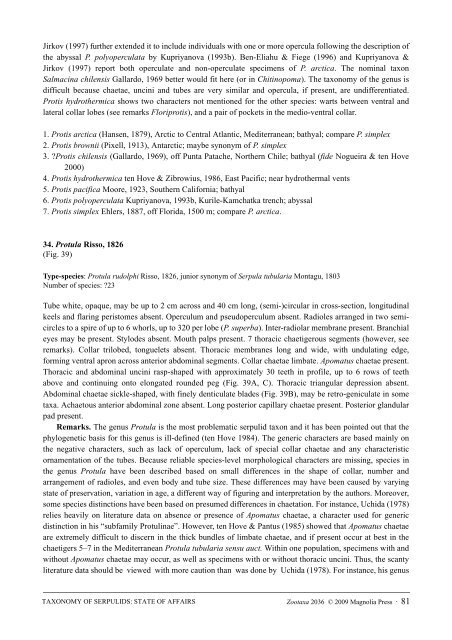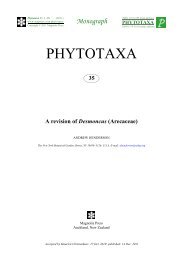Zootaxa, Taxonomy of Serpulidae (Annelida ... - Magnolia Press
Zootaxa, Taxonomy of Serpulidae (Annelida ... - Magnolia Press
Zootaxa, Taxonomy of Serpulidae (Annelida ... - Magnolia Press
Create successful ePaper yourself
Turn your PDF publications into a flip-book with our unique Google optimized e-Paper software.
Jirkov (1997) further extended it to include individuals with one or more opercula following the description <strong>of</strong><br />
the abyssal P. polyoperculata by Kupriyanova (1993b). Ben-Eliahu & Fiege (1996) and Kupriyanova &<br />
Jirkov (1997) report both operculate and non-operculate specimens <strong>of</strong> P. arctica. The nominal taxon<br />
Salmacina chilensis Gallardo, 1969 better would fit here (or in Chitinopoma). The taxonomy <strong>of</strong> the genus is<br />
difficult because chaetae, uncini and tubes are very similar and opercula, if present, are undifferentiated.<br />
Protis hydrothermica shows two characters not mentioned for the other species: warts between ventral and<br />
lateral collar lobes (see remarks Floriprotis), and a pair <strong>of</strong> pockets in the medio-ventral collar.<br />
1. Protis arctica (Hansen, 1879), Arctic to Central Atlantic, Mediterranean; bathyal; compare P. simplex<br />
2. Protis brownii (Pixell, 1913), Antarctic; maybe synonym <strong>of</strong> P. simplex<br />
3. ?Protis chilensis (Gallardo, 1969), <strong>of</strong>f Punta Patache, Northern Chile; bathyal (fide Nogueira & ten Hove<br />
2000)<br />
4. Protis hydrothermica ten Hove & Zibrowius, 1986, East Pacific; near hydrothermal vents<br />
5. Protis pacifica Moore, 1923, Southern California; bathyal<br />
6. Protis polyoperculata Kupriyanova, 1993b, Kurile-Kamchatka trench; abyssal<br />
7. Protis simplex Ehlers, 1887, <strong>of</strong>f Florida, 1500 m; compare P. arctica.<br />
34. Protula Risso, 1826<br />
(Fig. 39)<br />
Type-species: Protula rudolphi Risso, 1826, junior synonym <strong>of</strong> Serpula tubularia Montagu, 1803<br />
Number <strong>of</strong> species: ?23<br />
Tube white, opaque, may be up to 2 cm across and 40 cm long, (semi-)circular in cross-section, longitudinal<br />
keels and flaring peristomes absent. Operculum and pseudoperculum absent. Radioles arranged in two semicircles<br />
to a spire <strong>of</strong> up to 6 whorls, up to 320 per lobe (P. superba). Inter-radiolar membrane present. Branchial<br />
eyes may be present. Stylodes absent. Mouth palps present. 7 thoracic chaetigerous segments (however, see<br />
remarks). Collar trilobed, tonguelets absent. Thoracic membranes long and wide, with undulating edge,<br />
forming ventral apron across anterior abdominal segments. Collar chaetae limbate. Apomatus chaetae present.<br />
Thoracic and abdominal uncini rasp-shaped with approximately 30 teeth in pr<strong>of</strong>ile, up to 6 rows <strong>of</strong> teeth<br />
above and continuing onto elongated rounded peg (Fig. 39A, C). Thoracic triangular depression absent.<br />
Abdominal chaetae sickle-shaped, with finely denticulate blades (Fig. 39B), may be retro-geniculate in some<br />
taxa. Achaetous anterior abdominal zone absent. Long posterior capillary chaetae present. Posterior glandular<br />
pad present.<br />
Remarks. The genus Protula is the most problematic serpulid taxon and it has been pointed out that the<br />
phylogenetic basis for this genus is ill-defined (ten Hove 1984). The generic characters are based mainly on<br />
the negative characters, such as lack <strong>of</strong> operculum, lack <strong>of</strong> special collar chaetae and any characteristic<br />
ornamentation <strong>of</strong> the tubes. Because reliable species-level morphological characters are missing, species in<br />
the genus Protula have been described based on small differences in the shape <strong>of</strong> collar, number and<br />
arrangement <strong>of</strong> radioles, and even body and tube size. These differences may have been caused by varying<br />
state <strong>of</strong> preservation, variation in age, a different way <strong>of</strong> figuring and interpretation by the authors. Moreover,<br />
some species distinctions have been based on presumed differences in chaetation. For instance, Uchida (1978)<br />
relies heavily on literature data on absence or presence <strong>of</strong> Apomatus chaetae, a character used for generic<br />
distinction in his “subfamily Protulinae”. However, ten Hove & Pantus (1985) showed that Apomatus chaetae<br />
are extremely difficult to discern in the thick bundles <strong>of</strong> limbate chaetae, and if present occur at best in the<br />
chaetigers 5–7 in the Mediterranean Protula tubularia sensu auct. Within one population, specimens with and<br />
without Apomatus chaetae may occur, as well as specimens with or without thoracic uncini. Thus, the scanty<br />
literature data should be viewed with more caution than was done by Uchida (1978). For instance, his genus<br />
TAXONOMY OF SERPULIDS: STATE OF AFFAIRS<br />
<strong>Zootaxa</strong> 2036 © 2009 <strong>Magnolia</strong> <strong>Press</strong> · 81
















